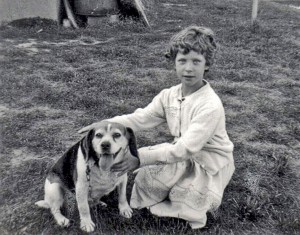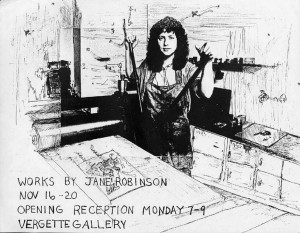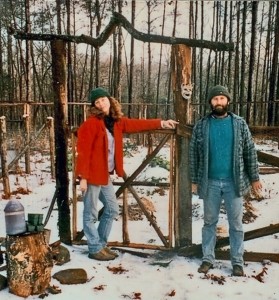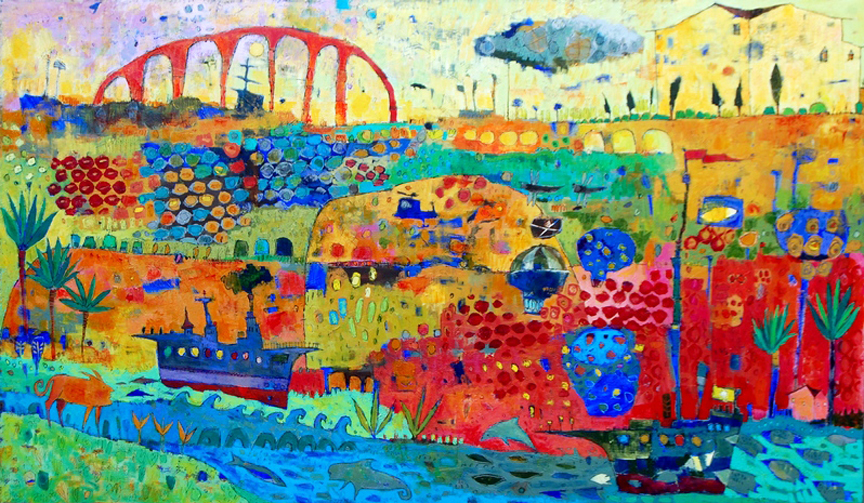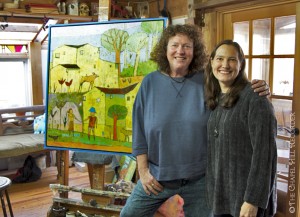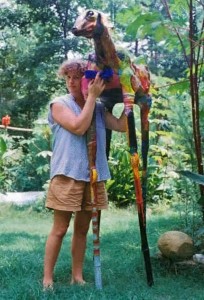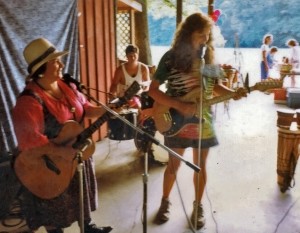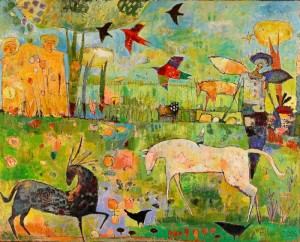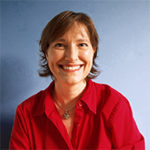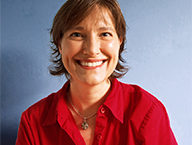The Fantastic Jane Filer
Jane Filer is a passionate artist and a devoted teacher who pours love into everything she does and shines light onto everyone she meets. Her paintings are internationally celebrated and revered, and as a teacher, she spent twenty-one years inspiring art students at the Carrboro ArtsCenter.
Although being a painter was clearly her intended path from a very young age, it took Jane a while to fully embrace her calling and become the successful artist she is today. This is how Jane Filer became a painter and ended up living in Chapel Hill, NC.
Jane Filer was born Jane Robinson in 1957 and grew up in San Jose, California. As a child, Jane was always drawing and painting. In Kindergarten, there was an hour every day where the children were free to choose an activity, ranging from building with blocks or playing in the play kitchen. Jane chose painting every single day. “I was painting with an odd seriousness,” Jane explains. “If there is such a thing as reincarnation, I must have been an artist, particularly a painter. Or you’re born with something — no one can say for sure. I had this thing. I was serious about it.” In second grade, Jane remembers one time when she was drawing a detailed water scene with sharks and SCUBA divers using crayons. “I had to go to the bathroom. I come back and I sit down and I look at my picture. It’s sitting on my desk and I say, ‘Wait a minute. Something’s wrong here.’ There was an extra shark in my drawing! Someone had come and sat down and drew an extra shark in my drawing! I was invaded! I was really mad. It was ruined! Those memories pointed to a direction for me.”
MOVING AROUND
When Jane was eleven, her parents suddenly decided to move all five children across the world from California to East Cannington, a tiny town in Western Australia, in hopes of buying a grape vineyard. She was immediately drawn to the Aboriginal art and culture there which still influences her paintings today. Two years later, they all moved to Michigan to be closer to family. For someone who dislikes cold weather as much as Jane does, she was miserable. “Can you imagine being in 7th grade, 13 years old, and never seeing snow in your life, and moving to a place like Michigan? It looked great but it felt horrible! We moved in early January, from Australia where it was summer, so we went from 105-degree days to minus 5 degrees. And I never saw real icicles before. I never saw real snow. But there would be these crazy people who would do these wild Christmas decorations, attach plastic icicles to their gutters and spray snow on their bushes — really extravagant, you know the type, we have them everywhere, and I love ‘em. It’s great, but I saw these icicles hanging there, and this snow, and I thought, ‘Man, everybody’s going wild here for Christmas,’ and then I got out and I’m like, ‘These are real!’ This is Michigan.”
Jane’s years in Michigan were tough, and the cold weather gave her chronic sinus headaches. She found high school boring but she excelled in high school art classes, although she never felt confident about her artistic ability. “I didn’t think I had any promise back then. I would look at other people who could draw really well, and other people’s paintings, and I always thought, ‘If I could do that.’ They were highly realistic.” After graduating from high school in 1975, Jane worked in a factory building Avion camper trailers in Benton Harbor, Michigan for a year. She used a pop rivet gun, bent ribs, sprayed foam insulation, put paneling up, cut windows, put windows in and caulked them.
But it was in Michigan, in 1976, when Jane sold her first painting. It was 18” x 24” and she had painted several red creatures flying through space. Jane remembers that day clearly. “Two brothers who were grounds keepers at the apartment complex, and also aspiring musicians, spotted one of my paintings. They said, ‘We want to buy this painting. How much do you want for it?’ I’m like, ‘Fifteen dollars.’ ‘No! Come on, take more!’ I said, ‘No, it’s all right.’ They said, ‘We’re going to use this for our album cover!’ I don’t know if they ever did, I can’t even remember their names. I just remember that was my first real sale. But I do know in high school, the guidance counselor asked me if she could have one of my pieces of art, and friends of mine — everybody wanted my art. I ended up not having anything left from high school, because I was just so flattered. ‘OK, sure, here!’” Even after all this praise and encouragement, it was her Godmother Aunt who finally convinced her to move to Chicago and study art.
THE ART STUDENT
For a year, Jane took art classes at the College of DuPage. She loved it, but was longing for warmer weather, so she transferred to Southern Illinois University. Once there, she resisted majoring in art, and chose instead to major in Communications. Jane struggled with the reality of becoming an artist, and often thought, “I can’t be an artist. It’s impossible. How am I going to make a living?” But she was miserable. Jane frequented a local bar named Jim’s in Carbondale where all the artists hung out. “I remember one time, this one artist was sitting there at Jim’s with his drawing pad open like he was going to draw, and you could see he was frozen. And I’m not even an art major, I’m not even an artist, and I’m thinking, ‘Why don’t you just draw? What’s wrong with you? Just draw!’ Everything’s ready, and he’s just frozen there. And I’m thinking, ‘Hmmm.’ And after that first year down in Southern Illinois, I declared an art major. I came alive in art school!”
Southern Illinois had a huge art department and offered studies in every artistic discipline — blacksmithing metals, illustration, drawing and painting. Surprisingly, Jane’s favorite medium there was not painting, but rather printmaking. “Printmaking is such an amazing medium. There’s so much to it, and so much still to be discovered. You could do so much to it — working with zinc metal plates, engraving, drypoint, monotypes, photo impressions, etching into the acid baths, and soft grounds, and it goes on and on what you can do with that.” Upon graduating in 1982, her command of this very technical art form won her the prestigious Rickert-Ziebold Trust Award, the highest award in the country, given to only seven graduating seniors nationwide. This honor gave Jane the boost of confidence she needed to finally commit to becoming a full-fledged artist. “I truly loved it, but there was that fear. There are a lot of fears to overcome. First of all, are you going to be happy or are you going to have money? I mean seriously. But for me it was happiness or money. This was making me happy. It was obviously something that I really wanted to pursue, like life’s work. I made a vow, like a monk would make a vow, to do this, and, if I was going to live in poverty, I was going to live in poverty. But I made a vow, just like that. By then I was 21 and I said, ‘I’m going to be an artist.’ I just poured myself into it.”
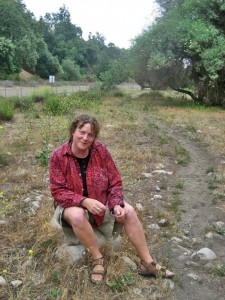 PLANTING TREES
PLANTING TREES
Winning the Rickert-Ziebold award gave Jane a free ticket to study fine art in the graduate school of her choosing. But she had just married a forester, John Filer, and instead took a year off to travel all over the United States reforesting strip mines for wildlife and replanting huge plantations for paper companies. They bought a camper, hooked it up to their ’78 Chevy van, and planted about 100,000 trees that year. “We were like nomads and we loved it. It was a rustic life, but I have to tell you, I was so lean and strong. I mean, you plant trees all day long, and you know, I could eat as many peanut butter and jelly sandwiches as I wanted, and I would lose weight, that’s how hard the work was.”
As they drove from town to town, Jane was constantly drawing in her sketchbooks and researching art departments at graduate schools. She was filling out applications by candlelight, or lanterns, with a little typewriter in her camper, in the middle of thousands of acres of timber. Throughout the process, Jane kept remembering what one of her favorite art teachers, Herb Fink, had told her. “Jane, you’re already an artist,” he said. “You’re going to do your work no matter where you go. My advice to you is just find some place that you will love to live, or that you will enjoy living in for a few years.”
ARRIVING IN CHAPEL HILL
How she decided on UNC-Chapel Hill for graduate school was completely random. “We came back to Illinois, and we were back in our camper. I was like, I don’t know, I don’t know. I even thought about Florida State and LSU. They just didn’t seem right –maybe too hot and too many pine trees. And so what actually happened was, I was running out of time. I was writing my applications, and I sat down at the little table in my camper and I opened the map. I thought, ‘I want warm climate.’ I grew up in San Jose, California and western Australia. I lived in Michigan for six or seven years, Chicago for a couple years, and I was not going to live in cold weather. It didn’t agree with me. I was looking at the map, and I thought, ‘OK, well, the climate looks good in North Carolina.’ And I really liked the Outer Banks, though I hadn’t been there before. There were about four states in the whole country that I hadn’t been in by that time in my life, because I had been so nomadic and we had been traveling and living so rustically. North Carolina was one of them. UNC-Chapel Hill had just built the new Hanes Art Building with large studios, so I applied and I was accepted.
John and Jane arrived in Hillsborough the day before classes started, and parked their camper at the Daniel Boone Campground. Jane’s first day on UNC’s campus went something like this. “I walked in on the first day of classes, and I went into the office, and I said, Well, I’m here. Could you show me where my studio is? The secretary said, ‘Well, who are you?’ And I said, ‘I’m Jane Filer, I’m a graduate student in studio art.’ And she says, ‘You need to talk to Dennis Zaborowski.’ He was the head of the department at the time. I go into Dennis’s office, and I say, ‘Hi, I’m Jane Filer, I’m here for studio art. Can you show me where my studio is?’ He looks at me and he goes, ‘This is the first day of classes.’ I say, ‘Yeah, I know.’ He’s like, ‘You’ve never been here before?’ and I say, ‘No, no, I didn’t have time. I was all over the country.’ I didn’t tell him why. He says, ‘What if you don’t like it?’ And I said, ‘I’ll hook my camper up to my van and I’ll drive away. What’s the big deal?’ That’s exactly what I told him. I remember telling him that, and he was like, ‘Well, okay, come along.’ He showed me my studio. It was a big beautiful studio. I stood there. It was totally empty and I didn’t have that much, but I tell you, in about four weeks I had it stuffed with everything I needed. I was in heaven! I had a studio again after almost a year of traveling around the country.”
Fortunately for us, Jane and John decided to stay in Chapel Hill and they love it. “Right away, I thought I could live here, and this is where I’m staying the whole rest of my days. It’s a spacious, liberal community. We’ve got all kinds of people living here, and we felt welcomed to live here. That’s really cool. I like the diversity and the creative culture. I love the countryside here. I love the dairy farms. When spring hits, and the daffodils bloom in February. I love walking in the woods. I’m also really proud of Chapel Hill Public Schools. They’re good. Good schools are going to inevitably create a good community, because you have people who are educated.”
FROM PRINTMAKER TO PAINTER
Even with the Rickert-Ziebold Trust Award helping to pay for her education, Jane was on a tight budget and had to be inventive when it came to acquiring art supplies. “When I got the list that the teacher gave me, and went down to the art supply store, I thought, ‘Aye! That’s what they cost? I can make these.’ I would make my own tools, like out of bones, when I was doing ceramics. I’d take embroidery needles and add them to twigs, and guitar strings with wooden knobs on the end. For a rib, I used a real rib, I sanded it, took a piece of sheet metal and grooved out a little handle on the edge of it. I remember working with my own tools in the ceramics studio, and I had them in a box, and somebody coming up to me, and pulling out my tools, and saying, ‘These are homemade tools! These are handmade tools!’ These other kids came up, and they’re like, ‘Neat! Cool!’
“I had the same thing happen with the etching inks. I went into the print shop, because I had already paid an extra fee to use the inks. They had all these different colors. I’ll tell you the colors that I used: white, burnt umber, black, blue, red, and yellow. Six colors, that’s all I had. I would go into the print shop, and I’d get these thick inks, and I would add linseed oil and turpentine to them, and I would make paint of out them. They come up and they’re like, ‘Man I hear you’re using etching ink for paint!’ They thought that was really neat.”
Jane wanted to major in printmaking at UNC, but she was told that wasn’t an option. She started out making prints for her first critique anyway, since that was what she loved to do, but the printmaking process is complicated and lengthy. After a month, she only had four pieces completed, and Jane felt like her professors would want to see more work. She decided she needed to throw in a few paintings as well, to fill up the space. What began as just filler for a critique became Jane’s life work. Little by little, Jane started painting more and doing less printmaking. “I really didn’t think I was going to paint this many years. One painting led to the next painting, led to the next painting, led to the next painting. At first it was trying to do something, and trying to do something, and then I did it. I was like, ‘Wow, that was great! Look at this! This is great!’ And then, ‘All right now, let’s see what we can do with this.’ One thing just led to another. A body of work just started to happen. I was really interested, because in printmaking, and I love printmaking, it’s so time consuming. An 18×24-inch etching plate can take you two weeks of labor, and I put in 8-10 hours days. I’d be working away, and then at the end of two weeks I would have one print. But at the end of two weeks after of eight hours a day of painting, I would have a lot of studies and then something really involved. So when the teachers come in, because what they do is decide if you can stay or not, they’d come in and there’s a whole lot of stuff all over the walls just to blow them away. I wasn’t thinking I was going to paint this long.”
TEACHING
After graduating from UNC with an MFA in 1985, Jane worked various jobs to make ends meet while she painted. Her last “real” job was working for the Village Advocate in the dark room. Getting to work by 6:00 am was really difficult, and she quit after seven weeks. Then she cleaned houses for a while and enjoyed the flexibility of that. In 1986, Jane found her niche when she started working at the Carrboro ArtsCenter as a drawing and painting teacher. “I actually taught one class, then cleaned houses a couple days a week. Then I started doing more ArtsCenter classes and eventually stopped cleaning houses.” For the next 21 years, Jane inspired thousands of art students and helped launch the careers of innumerable local artists.
In 1995, I had the privilege of taking one of Jane’s drawing classes. Because of her gifted teaching ability, the work I produced in her class is still some of my best work. Her enthusiasm in the classroom was contagious, and there was such a warm, positive energy in the room. I always left class feeling excited, supported and most importantly, confident as an artist. Jane explains her teaching philosophy: “I would try to get my students to create something they would want, maybe want to keep or take home and frame. With my cartooning and comic bookmaking kids, I wanted them to make books that they or their mothers would keep forever. That’s come to fruition. I’ve run into kids that I taught, and a lot of them still have their comic books.” In 2006, Jane decided to devote all of her time to painting, and she retired from teaching at the ArtsCenter. In her honor, the ArtsCenter officially named her classroom “The Jane Filer Painting Studio.”
Even though Jane no longer teaches in a classroom, she will always be a teacher at heart. This will be the 6th year for her artist’s retreat “Painting by the Sea with Jane Filer” located at the Trinity Center on Emerald Isle, NC. She teaches 32 to 40 artists, and most of them return every year. Jane also continues to mentor upcoming artists, giving critiques and advice. “My closest artist friends always have an easel here, so they can come, plop their stuff down and hang with me for a few hours and paint.”
BUILDING A HOME
In 1986, Jane and her husband John purchased a 16-acre tract of timber in rural Orange County. “We put in a road, hooked up the camper to the septic field, drilled the well, added electricity, and built a little lean-to on the camper. We pulled logs out of power line right of ways and took them to sawmills. That was pretty neat. John’s brother Paul, traveled out from Illinois to help build our rustic studio/home. John and Paul harvested trees from our new property. We were struggling back then. Our hardwood floor is a mixture of red and white oak, and tongue & grove pine in the studio. Somebody at Lowe’s broke a bag of cement on a room full of hardwood flooring and we bought it cheap. John cut off the part that was discolored by the cement dust and we pieced the clean oak together. We were really clever. We worked and earned extra money at the Carrboro Farmer’s Market on Saturdays and kept building.” Four years later, they were able to move in, and the end result is a beautiful, handcrafted work of art itself.
A DEDICATED ARTIST
Jane Filer is definitely one of our most successful local artists, but as much as she loved painting and wanted to commit to being a painter, it took her many years to have the confidence to devote herself to being a full-time artist. “What happened to me, I was probably 35, (and I’m 54 now), I was sitting right here on this couch one night and I had a sketch book. I always keep books that I write thoughts in and draw pictures in. I automatically wrote this note to myself, ‘Jane, the universe has made a place for you. Step into it. The universe has made time and space for you.’ I was writing to myself. When I wrote that the universe created a slot for me… I thought, ‘Yeah, wow, okay.’ What I told myself was, ‘Pour yourself into it.’ And so I did. I just poured myself into painting.”
Jane wanted to find some Gallery representation in Durham or Chapel Hill. So one snowy night, Jane looked up at the sky and said to the universe, “Here’s what I’m thinking.” And she spelled out this whole vision of how she wanted her life to look. “I needed help. I was standing there in this beautiful, cold, starlight night, and I swear this is the truth, I said, ‘I need a sign.’ I always said to John, ‘Don’t worry honey, I’m going to really make it, and we’re going to do good.’ But at that time in my life, I really needed some sort of confirmation. And I repeated, ‘I need a sign, and I would like to see a falling star.’ I said that, and I closed my mouth, and a star fell. I stopped for a second and I just said, ‘Coincidence? Maybe!’ But I went back inside, determined to make it work. And then Jane Tyndall of Tyndall Galleries called me about six months later. It was so weird, every month after that, I was hired for another commission, or someone would say, ‘Can I see what you have for sale?’”
It was then that Jane made one of her fist big sales. The painting sold for $2100, which was about the same price as a Martin acoustic cutaway J40 guitar that Jane really wanted to buy. “John said to me, ‘When you sell your first $2500 painting, buy a $2500 guitar.’ You know? I love that guitar.”
Since then, Jane has sold over 2,000 paintings (which according to her, is the equivalent of a few gold records), and when she has a gallery opening, she will often sell out in just a few hours. She no longer has to tell herself that if this doesn’t work out, she can always go back to cleaning houses. “I’ll never have to do that again. I know it. I’m in too many collections, too many prestigious collections. That’s one of the things that makes my paintings valuable. The different corporations and the different people that collect art, and museums who want my pieces — like the schools that I went to. UNC owns a couple of my paintings. The Faner Museum in Southern Illinois bought one of my paintings, too. Not only that, Duke Hospital, and hospitals all over the country, corporations and business have purchased my work, like IBM, Eileen Naughton, Ad Exec for Google – NYC, and Kevin Klose, retired CEO of National Public Radio owns one titled Conversation.”
DOING WHAT SHE LOVES TO DO
Nevertheless, Jane acknowledges all of the fear and challenges that are involved when choosing a creative profession as a career, whether it is fine art, music, acting or dance. When you find your true calling, it can be tough rising above the naysayers who doubt your ability to be successful and support yourself. Jane encountered this often and it was discouraging. “When I first started selling really well, I was still an art student and had sold $3,000 worth of paintings that year. I broke my leg after a bad wreck on a motorcycle, right before I had my first art show. I was in the hospital for a week, and this nun came in to the room to talk to me. She’s like, ‘What are you in school for?’ I said, ‘I’m going to be an artist.’ ‘You can’t make a very good living with that, can you?’ I remember thinking, ‘You’re a nun! Don’t you know anything about being devoted to something?’ I remembered, I said, ‘Last year I made three thousand dollars.’ And she said, ‘Oh, well, that’s not too bad!’ And I say, ‘You know, I’m not doing it for the money.’
“Because, for over five years after that, I was losing money. I wasn’t doing it for the money. If you’re doing it for the money, oh, go do something else. In the beginning, you can make better money. Art is hard. Do it for love of doing it. There’s something that drives me, there’s something I need to explore. I discover things about myself and being human and being in the world. I’m devoted to it. I don’t do it for money, you know? I make a living at it now, thank God. But those people that think they could do it for money are not going to make really very good art. You got to be out after something else. That’s actually what the world wants. You’re a philosopher of sorts, and you want to give something genuine to the whole continuum. And it shows in the work.
“My students ask me how to get gallery representation. I tell them, ’Just make good art.’ The galleries will come. Since 1999, I’ve been in 21 commercial galleries from Maine to Florida, Texas and Arizona. These galleries have all approached me, unlike the early days. Some have closed and I pulled out of several others. I now have eight galleries.
“I have helped launch a lot of art careers. I’ve helped a lot of artists. I can’t even name them all. But I’ve seen all the different attitudes people have. A lot of people say to me, ‘Oh, it must not be fun anymore since you’re making a living at it.’ I’m like, ‘What? Why wouldn’t it be fun? What?’ If you’re an artist and you have to clean houses or teach at the University, so that you can be an artist, or if you can make a living at being an artist so you can be an artist full-time, 8 hours a day, 40 or 50 hours a week, how many weeks in a year, year after year, what’s better? (I need to live about 300 more hundred years to be able to get the ideas out that I’ve got in me, and even then at the end of that, I’d have more!) If you’re a scientist, and you’re trying to discover something, and you have to be a janitor at the gym, and you work 8 hours a day, and at night for a couple of hours you’re doing your research, what good is that? If you could do your research or your art, more, that’s great! That’s what I want. Why do people have drudgery mixed up with work?
“When I’m frustrated and when I’m really frazzled and when I’m at my wit’s end, it’s because I have too many other things to do besides my art. And if I have a show coming up, that’s when people will say, ‘It’s really not fun for you anymore, is it?’ That tells me a lot about human nature, because most people don’t work for fun. If you do what you love, you’re going to do it well. That’s what the world wants. The world wants good paintings.”
Good paintings are indeed what the world wants and needs. As long as Jane Filer continues to paint, Chapel Hill and the rest of the world will have these wonderful paintings of hers to enjoy for many years to come. We are truly blessed to have her as an integral part of our community.
UPCOMING EVENTS
Catch some of Jane Filer’s “Heads” in the 6th Bi-Annual Handmade Parade in Hillsborough on Saturday, October 16, 2016! For more information about Jane Filer and her paintings, visit her website: www.janefiler.com.
Click here to read more about Jane Filer’s paintings, her process and teachings in The Chapel Hill Recorder article: “The Paintings of Jane Filer.”
Category: People, Popular Articles


